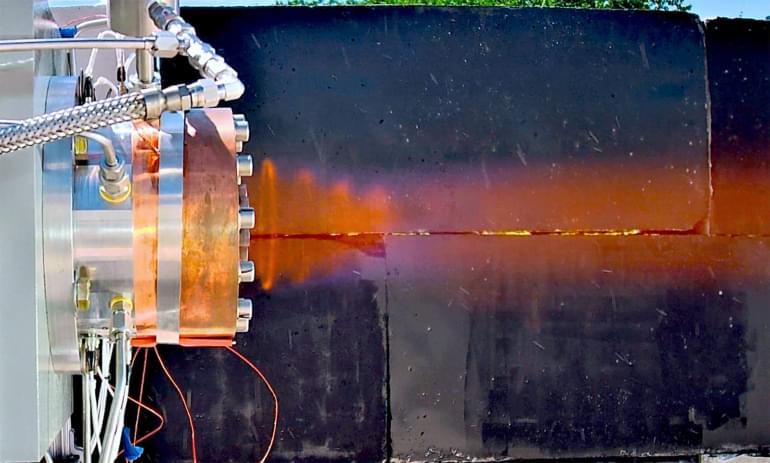8,794 likes, — daily_learningfacts on October 20, 2024: ‘Drone Show in China #dailylearningfacts #shortvideo #facts #fyp #usa #viral’



In a major jump into the era of eVTOL air taxis and multicopter cargo drones, the US FAA has issued new regulations that introduce the first new aircraft category, called “power-lift” aircraft, since modern helicopters were introduced in the 1940s.
According to the FAA and the International Civil Aviation Organization (ICAO), a power-lift aircraft is “a heavier-than-air aircraft capable of vertical take-off, vertical landing, and low-speed flight, which depends principally on engine-driven lift devices or engine thrust for the lift during these flight regimes and on non-rotating aerofoils for lift during horizontal flight.”
Essentially, this means aircraft that combine the characteristics of both fixed-wing planes and helicopters. In other words, they can take off, hover, and land like helicopters, yet act like fixed-winged craft in horizontal flight. As of now, these include convertiplanes, tilt-rotors, tilt-wings, rotor-wings, tail-sitters, and VSTOL aircraft like the Harrier and the F-35B Lighting II that use vector thrust, lift jets, or lift fans for vertical flight.
Molecular nanotechnology may have the power to completely revolutionize human living.
Drone in D by Kevin MacLeod is licensed under a Creative Commons Attribution license (https://creativecommons.org/licenses/by/4.0/)
Source: http://incompetech.com/music/royalty-free/index.html?isrc=USUAN1200044
Artist: http://incompetech.com/
1GITEX Global 2024 and IROS 2024 became true gateways to the future of technology, bringing together the most advanced innovations in artificial intelligence, robotics, and transportation under one roof. At the forefront of GITEX was the unique Nissan Hyperforce concept, an electric vehicle with an incredible 1,360 horsepower, capable of accelerating from 0 to 100 km/h in just 2 seconds. This electric supercar not only stunned with its speed but also with its futuristic design, reminiscent of the iconic Batmobile. With its advanced driving modes, R and GT, drivers can switch between a sporty and comfortable driving experience.
👉For business inquiries: [email protected].
✅ Instagram: / pro_robots.
0:00 Exhibitions in the United Arab Emirates.
0:34 GITEX GLOBAL 2024
0:47 Nissan Hyper Force supercar.
1:43 Italdesign’s Quintessenza concept car.
2:39 Ameca robot.
3:15 Robot bartender.
3:38 Airscooter by Zapata.
4:13 Autonomous Patrol of the Future by Dubai Police.
5:09 Tesla Cybertruck.
6:01 All-terrain delivery vehicles from Mobinn.
6:20 Cadillac Electric Flyer.
7:03 Drones by Multi Level Group.
7:32 Xpeng Aeroht Flying Car.
8:18 New humanoid robot Kepler.
8:42 ZainTECH Drones.
9:04 Robo-charging electric cars.
9:43 Odigo robot with AI
10:26 IROS 2024
11:02 Obstacle course for four-legged robots.
11:41 Robofootball on IROS 2024
12:32 High Torque Robotics.
13:03 Unitree robots.
13:39 Nimble Direct Drive Robots.
14:16 Elephant Robotics.
14:47 Humanoid robots on display.
15:14 DexNex teleoperated system.
15:47 Hubot robot.
In addition, GITEX 2024 showcased the latest flying car concepts. Among them was a model capable of unfolding its blades and taking off in just two minutes, making it the perfect vehicle for fast, seamless travel both on the road and in the sky. The exhibition also featured other cutting-edge innovations, such as autonomous patrol cars equipped with drones and robotic bartenders that serve drinks without lines or fuss.
IROS 2024, held in Abu Dhabi, was equally impressive, giving a glimpse into the future of robotics. Highlights included thrilling competitions between robot dogs and humanoid robots, as well as demonstrations of new robots capable of running, jumping, and even performing complex acrobatic tricks. Autonomous robots designed for patrolling and delivery, capable of navigating routes and recognizing objects in the toughest conditions, also drew significant attention.
Both exhibitions revealed how robotics and AI are increasingly influencing our everyday lives, offering solutions for safety, transportation, and even entertainment. Unique projects, such as autonomous drones for agriculture and firefighting, and robotic systems for smart cities, are already reshaping urban spaces. With the technologies presented at GITEX and IROS, the future is closer than ever. Subscribe to our channel to stay updated on the latest innovations and events in the world of high-tech.

In a remarkable feat of engineering and automation, China has recently completed the world’s first fully unmanned road resurfacing project, covering an impressive 157.79 kilometres of expressway without the involvement of a single human construction worker. This innovative achievement showcases China’s rapid advancements in construction technology and its commitment to pushing the boundaries of what’s possible in infrastructure development.
The Autonomous Fleet
The project utilised a fleet of autonomous road construction vehicles, including drones and robots, to carry out the entire resurfacing process. This cutting-edge approach marks a significant departure from traditional road construction methods, which typically rely heavily on human labour.
Jetson Founder Tomasz Patan is clearly getting very comfortable with the Jetson One eVTOL’s flight control system … Watch him wrench the controls around to show off how sharply – and safely – this thing can handle tight turns in flight.
Multicopter drones were revolutionary little gadgets when they started to appear on the scene for a number of reasons, but one was their highly automated fly-by-wire control systems. No human could manually control motor speeds on upwards of four rotors simultaneously, but a sensor-equipped flight control system certainly could – hence, drones like the DJI Phantom were able to automatically lift off and land, maintain altitude if required, and self-balance against wind gusts to hover in place, while also responding quickly to a pilot’s commands.
This is part of the promise with eVTOL aircraft – some of which, like the Jetson One, are really best described as great big multicopter drones a person can sit in.
Airbus U.S. Space & Defense announced on October 15, 2024, the successful completion of the first demonstration of the Lakota UH-72 drone helicopter for the U.S. Marine Corps, conducted at Marine Corps Air Station New River and Camp Lejeune. This demonstration showcased the capabilities of the Aerial Logistics Connector (ALC) system, designed to enhance logistical support in dispersed and challenging environments. As an autonomous platform, the Lakota UH-72 ensures a continuous supply flow without relying on traditional transportation methods, which are often vulnerable or limited.

Nets wont do it, nets wont cut it, and to me, nets say: we dont know and we sorta give up. We need One System to be able to engage All Types and All Classes of drones, w/ EMF — RF jammers, Microwaves, Lasers, Projectiles, and Missiles. All acting simultaneously, to engage a So Called Drone Swarm.
U.S. Air Force officials at Langley Air Force Base in Virginia are looking at installing anti-drone nets to help protect F-22 Raptor stealth fighters on the flightline. This comes nearly a year after the base was subjected to waves of still-mysterious drone incursions, which The War Zone was first to report. It also underscores the U.S. military’s continued lag when it comes to responding to the very real threats posed by uncrewed aerial systems, at home and aboard, and particular hurdles to doing so domestically.
Langley’s 633rd Contracting Squadron put out a notice on October 4 asking for information about potential counter-drone netting that could be installed around up to 42 existing open-ended sunshade-type shelters at the base. Langley, now technically part of Joint Base Langley-Eustis, is one of a select few bases to host F-22s and is a key component of the Air Force’s posture to defend the U.S. homeland.
The 633rd “is in the process of determining the acquisition strategy to obtain non-personal services for the Unmanned Ariel Services (UAS) Netting for East Ramp Metal Sunshades,” according to the contracting notice. “The intention of the netting is to deter and ultimately prevent the intrusion of UAS’s near airmen and aircraft. This initial sunshade netting installation on the metal sunshade (bay Alpha 1) shall serve as a proof of concept for the remaining sunshades.”
First-person drone piloting is yesterday’s news. Drones are becoming smarter as the electronic environment around them makes operator communication more difficult.

There are several organizations and start-ups across the world that are working on developing hypersonic jets capable of flying at speeds above Mach 5 (3,836 mph). However, a propulsion system capable of providing sustained thrust at those speeds continues to be the biggest hurdle. Texas-based start-up Venus Aerospace has revealed a groundbreaking engine that has the potential to completely revolutionize high-speed air travel. Called the Venus Detonation Ramjet 2000 lb Thrust Engine (VDR2), the advanced propulsion system was unveiled at the recent Up. Summit in Bentonville, Arkansas.

The VDR2 is engineered to power drones and aircraft to hypersonic speeds, allowing them to travel vast distances at high altitudes with unmatched efficiency. The hypersonic propulsion system combines the high thrust and efficiency of the Rotating Detonation Rocket Engine (RDRE) with the high-efficiency cruise of a Ramjet. Developed by Venus in partnership with high-speed air combustion specialist Velontra, the VDR2 will operate as a single engine offering propulsion from take-off to attaining speeds up to Mach 6.
Also read — Boom Supersonic’s superfactory, which will be building the ‘son of Concorde,’ will be completed by spring this year. The first assembly line at the North Carolina facility will roll out 33 supersonic aircraft each year, capable of flying passengers from New York to London in 3.5 hours.